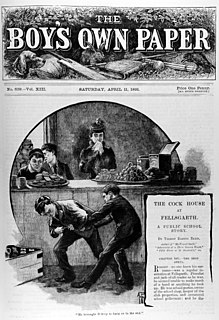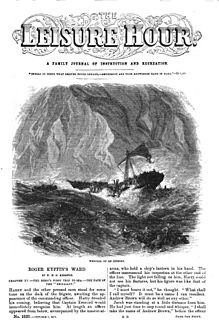
A magazine is a periodical publication which is printed in gloss-coated and matte paper or electronically published. Magazines are generally published on a regular schedule and contain a variety of content. They are generally financed by advertising, by a purchase price, by prepaid subscriptions, or a combination of the three.

Pulp magazines were inexpensive fiction magazines that were published from 1896 to the late 1950s. The term pulp derives from the cheap wood pulp paper on which the magazines were printed. In contrast, magazines printed on higher-quality paper were called "glossies" or "slicks". The typical pulp magazine had 128 pages; it was 7 inches (18 cm) wide by 10 inches (25 cm) high, and 0.5 inches (1.3 cm) thick, with ragged, untrimmed edges.

Pound sterling, known in some contexts simply as the pound or sterling, is the official currency of the United Kingdom, Jersey, Guernsey, the Isle of Man, Gibraltar, South Georgia and the South Sandwich Islands, the British Antarctic Territory, and Tristan da Cunha. It is subdivided into 100 pence. The Pound sterling is the oldest currency in continuous use. A number of nations that do not use sterling also have currencies called the pound.

Asimov's Science Fiction is an American science fiction magazine which publishes science fiction and fantasy named after science fiction author Isaac Asimov. It is currently published by Penny Publications. From January 2017, the publication frequency is bimonthly.

Ladies' Home Journal was an American magazine published by the Meredith Corporation. It was first published on February 16, 1883, and eventually became one of the leading women's magazines of the 20th century in the United States. From 1891 it was published in Philadelphia by the Curtis Publishing Company. In 1903, it was the first American magazine to reach one million subscribers.

Radio Times is a British weekly magazine which provides film reviews, radio and television listings. It was the world's first broadcast listings magazine when it was founded in 1923 by John Reith, then general manager of the British Broadcasting Company.

The Saturday Evening Post is an American magazine, currently published six times a year. It was published weekly under this title from 1897 until 1963, then every two weeks until 1969. From the 1920s to the 1960s, it was one of the most widely circulated and influential magazines within the American middle class, with fiction, non-fiction, cartoons and features that reached millions of homes every week. The magazine declined in readership through the 1960s, and in 1969 The Saturday Evening Post folded for two years before being revived as a quarterly publication with an emphasis on medical articles in 1971. As of the late 2000s, The Saturday Evening Post is published six times a year by the Saturday Evening Post Society, which purchased the magazine in 1982. The magazine was redesigned in 2013.

New York is an American biweekly magazine concerned with life, culture, politics, and style generally, and with a particular emphasis on New York City. Founded by Milton Glaser and Clay Felker in 1968 as a competitor to The New Yorker, it was brasher and less polite, and established itself as a cradle of New Journalism. Over time, it became more national in scope, publishing many noteworthy articles on American culture by writers such as Tom Wolfe, Jimmy Breslin, Nora Ephron, John Heilemann, Frank Rich, and Rebecca Traister.

Penny dreadfuls were cheap popular serial literature produced during the nineteenth century in the United Kingdom. The pejorative term is roughly interchangeable with penny horrible, penny awful, and penny blood. The term typically referred to a story published in weekly parts, each costing one penny. The subject matter of these stories was typically sensational, focusing on the exploits of detectives, criminals, or supernatural entities. First published in the 1830s, penny dreadfuls featured characters such as Sweeney Todd, Dick Turpin and Varney the Vampire. The Guardian described penny dreadfuls as “Britain’s first taste of mass-produced popular culture for the young.”

The Penny Magazine was an illustrated British magazine aimed at the working class, published every Saturday from 31 March 1832 to 31 October 1845. Charles Knight created it for the Society for the Diffusion of Useful Knowledge in response to Chambers's Edinburgh Journal, which started two months earlier. Sold for only a penny and illustrated with wood-engravings, it was an expensive enterprise that could only be supported by very large circulation. Though initially very successful—with a circulation of 200,000 in the first year—it proved too dry and too Whiggish to appeal to the working-class audience it needed to be financially viable. Its competitor—which included a weekly short story—grew more slowly, but lasted much longer.
Ally Sloper's Half Holiday was a British comics magazine, first published on 3 May 1884. It is regarded to be the first comic strip magazine to feature a recurring character. Star Ally Sloper, a blustery, lazy schemer often found "sloping" through alleys to avoid his landlord and other creditors, had debuted in 1867 in the humour magazine Judy — created by writer and fledgling artist Charles Henry Ross and inked and later fully illustrated by his French wife Emilie de Tessier under the pseudonym "Marie Duval".

Flight International is a weekly magazine focused on aerospace. Published in the United Kingdom and founded in 1909 as "A Journal devoted to the Interests, Practice, and Progress of Aerial Locomotion and Transport", it is the world's oldest continuously published aviation news magazine.
TheMercury is a daily newspaper, published in Hobart, Tasmania, Australia, by Davies Brothers Pty Ltd, part of News Corp Australia and News Corp. The weekend issues of the paper are called Mercury on Saturday and Sunday Tasmanian. The current editor of TheMercury is Jenna Cairney.

The Penny Cyclopædia published by the Society for the Diffusion of Useful Knowledge was a multi-volume encyclopedia edited by George Long and published by Charles Knight alongside the Penny Magazine. Twenty-seven volumes and three supplements were published from 1833 to 1843.

The Weekly News was a British national newspaper founded in 1855 and published every Wednesday by the Dundee newspaper chain DC Thomson. Billed as "the paper with the feelgood factor," it contained news and features on a broad range of subjects in six colour-coded sections: That's Real Life, Entertainment, Lifestyle, Puzzles, Short Stories and Sport.

Magazines intended for boys fall into one of three classifications. These are comics which tell the story by means of strip cartoons; story papers which have several short stories; and pulp magazines which have a single, but complete, novella in them. The latter were not for the younger child and were often detective or western in content and were generally greater in cost. Several titles were published monthly whereas the other two categories were more frequent.
Cassell & Co is a British book publishing house, founded in 1848 by John Cassell (1817–1865), which became in the 1890s an international publishing group company.

The Leisure Hour was a British general-interest periodical of the Victorian era which ran weekly from 1852 to 1905. It was the most successful of several popular magazines published by the Religious Tract Society, which produced Christian literature for a wide audience. Each issue mixed multiple genres of fiction and factual stories, historical and topical.
The history of journalism in the United Kingdom includes the gathering and transmitting of news, spans the growth of technology and trade, marked by the advent of specialised techniques for gathering and disseminating information on a regular basis. In the analysis of historians, it involves the steady increase of the scope of news available to us and the speed with which it is transmitted.

Taxes on knowledge was a slogan defining an extended British campaign against duties and taxes on newspapers, their advertising content, and the paper they were printed on. The paper tax was early identified as an issue: "A tax upon Paper, is a tax upon Knowledge" is a saying attributed to Alexander Adam (1741–1809), a Scottish headmaster.

















